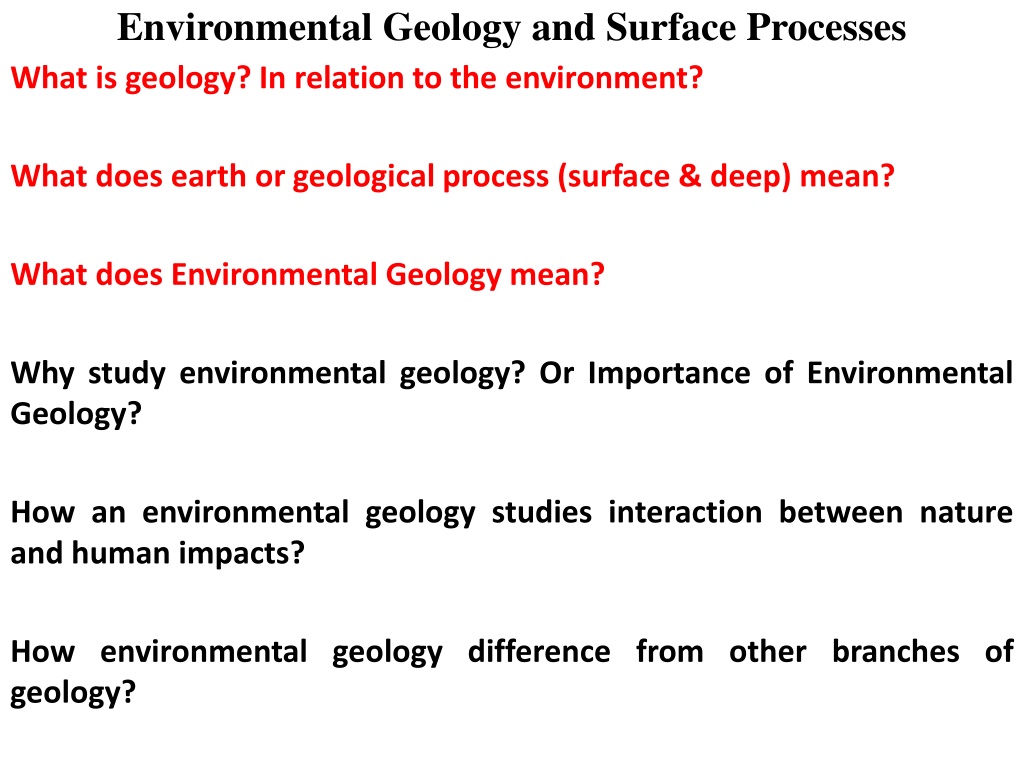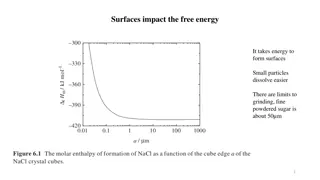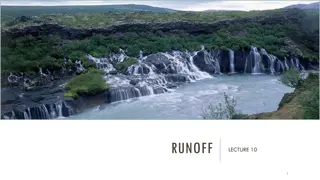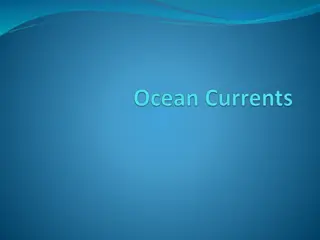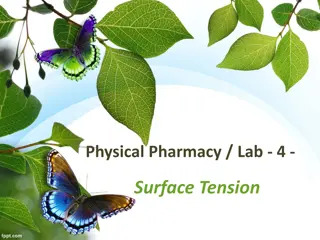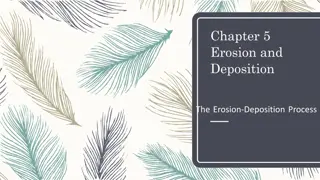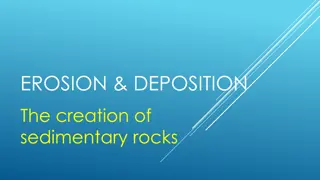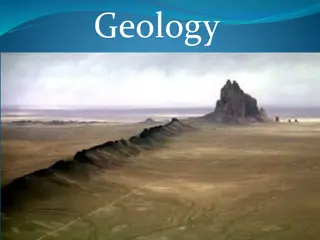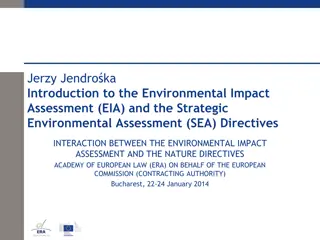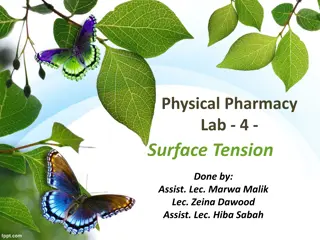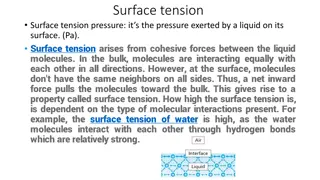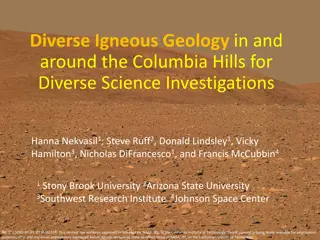Environmental Geology and Surface Processes
Geology in relation to the environment involves studying Earth's geological processes, both surface and deep, and their impacts on nature and human activities. Environmental geology focuses on the interaction between humans and the Earth's near-surface environment, addressing hazards like erosion, flooding, earthquakes, and volcanic eruptions. It explores the dynamics of planet Earth and its surface processes, emphasizing the importance of managing natural resources and protecting the environment for sustainable living.
Download Presentation

Please find below an Image/Link to download the presentation.
The content on the website is provided AS IS for your information and personal use only. It may not be sold, licensed, or shared on other websites without obtaining consent from the author.If you encounter any issues during the download, it is possible that the publisher has removed the file from their server.
You are allowed to download the files provided on this website for personal or commercial use, subject to the condition that they are used lawfully. All files are the property of their respective owners.
The content on the website is provided AS IS for your information and personal use only. It may not be sold, licensed, or shared on other websites without obtaining consent from the author.
E N D
Presentation Transcript
Environmental Geology and Surface Processes What is geology? In relation to the environment? What does earth or geological process (surface & deep) mean? What does Environmental Geology mean? Why study environmental geology? Or Importance of Environmental Geology? How an environmental geology studies interaction between nature and human impacts? How environmental geology difference from other branches of geology?
This course generally Provides an overview of Geological processes influencing natural resources: water, soil, air, mineral and energy resource availability; The environmental impacts associated with utilization of these resources; Near surface processes influencing humans including: erosion, floods, and land slides; land subsidence How they occurred? How can evaluate? Deep geological processes controlling catastrophic events such as earthquakes and volcanoes. The Earth's climate-past, present and future
The focus is On the technical aspects of human interaction with the near- surface environment of Earth. Concept of Environmental Geology And other relevant topics Near surface related hazards (soil erosion, flooding, mass wasting, landslide, debris flow, coastal erosion). Tectonic hazards (earthquakes, tsunamis, ground disturbance, volcanic eruptions), How they occurred all these evens? Outcomes of understanding these events on the overall management of the environment / saving the globe Water resource issues (source, supply and quality), Engineering geology, mining impacts, and waste management.
Learning outcomes: Introduce students to the dynamics of how planet earth works, Explore the major processes that shape the surface of the Earth, Investigate the interactions between the land, the sea and the atmosphere Biosphere (hydrosphere, lithosphere, atmosphere) To define the relationship between our planet and the rest of the environs.
Generally, The earth is a system consists of: Atmosphere, Hydrosphere , Biosphere, Lithosphere The earth itself is an open system with respect to energy (sun as source) The earth is a closed system with respect to natural cycles The environment is that total set of circumstances that surround an individual or community: Physical conditions Air, water, soil, landforms Social and cultural conditions Ethics, Economics, Aesthetics But the earth is the only suitable habitat we have, and its resources are limited. In two ways; Finding resources is not so much a problems as is finding ways to use them, or Finite resources cannot support an exponential increase of people forever Regardless of the reason, there is Limitation of Resources
Conti. While our population grows and our demands for resources increase, We place greater stress on the environment's ability to provide essential products and absorb waste materials. Population Growth lead to Shortages Food supplies, renewable, elastic within limits Mineral resources not generally renewable, land Changes in global environment deforestation , Desertification, overgrazing salinization by irrigation over, over-cultivation Pollution Sources (Individual, Industry Types (Water Pollution; Persistent substances, DDT, mercury, lead Non-persistent, Organics substances, Air pollution Because of The ever-increasing demand for resources, The growing exposure to natural hazards, and The changing climate, Geology is of considerable societal relevance.
To cop up the complexity of these different disciplines: The Planet earth, geology, geological processes & the environment; It has been restructured in to four parts Part one: Geology (physical, historical and environmental) Foundations of Environmental Geology Philosophy and Fundamental Concepts about Internal Structure of Earth and Plate Tectonics Minerals and their importance Rocks (Igneous, Sedimentary, Metamorphic)
Part two: Geological Processes Major processes that shape the surface of the Earth or our globe Natural & artificial stresses affecting the environmental What does geological processes mean? The movement of the continents, What does mean? How they move? Why we study? Land forms (mountain formation, etc.) How forms hill side and flat lands ? How ruled the system? Deep geological processes (earthquakes & volcanoes) Plate Tectonics (Divergent Boundaries, Convergent Boundaries, Transform Fault Boundaries and why Does Plate Tectonics Occur? controlling catastrophic events How these all geological processes occur? Both processes needs Energy (deriving force) Energy, Forms of Energy, Sources of Energy, Heat Transfer
Geological Processes (surface and deep) Worldwide distribution of earthquakes and volcanoes How can evaluate? And why study? Its application? And aspects of evolution (time frame) e.g. Archian, Precambrian, Mesozoic and volcanic rocks All these depends on an understanding of plate tectonics the very slow movement of solid continental plates across a plastic lower layer Crust mantle core Near surface processes controlling resources found at and near surface Erosion, flooding, and landslides; Deserts and Wind, and Water, soil, Mineral, Energy Resources Then; Surface and subsurface geological processes and environmental issues, Rock types (or geological features) and environmental issues e.g. Erosion, flooding, and landslides; Deserts and Wind, and Water, soil, Mineral, Energy Resources
Geological processes and Natural Hazards Introduction to Natural Hazards Near surface related hazards (Erosion, flooding, mass wasting, landslide, debris flow), Deserts, Wind etc. Deep geological processes and related hazards are Earthquakes and Related Phenomena Tectonic hazards (earthquakes, ground disturbance, volcanic eruptions), Tsunami, Volcanic Activity Slope Processes, Landslides, and Subsidence
Then Geologic Cycles (Igneous, Sedimentary, Metamorphic) These are called geological features or terrains Hydrologic Cycle, Catastrophism, Hazardous Processes Rock deformation (Rock weathering, Soil formation), Either due the surface processes (solar heat, human impact, mining etc.) or Due tectonic processes or volcanic impacts (Geological Folds, faults, etc.) Erosion, deposition forming land forms (land scape) These near surface processes influencing humans including: Erosion, flooding, and landslides; Deserts and Wind, and Water, soil, Mineral, Energy Resources How?
Finally, Engineering geology, mining impacts, and waste disposals How these and other geological processes affects the system? The relationship between our planet and the rest of the environs or Interactions between the land, the sea and the atmosphere i.e. Biosphere (hydrosphere, lithosphere, atmosphere)
PART THREE: Resources and Pollution Water Resources and Water Pollution Mineral Resources and Energy Resources Soils and Environment The water resource issues (surface & subsurface, source, quantity & quality and overall global water balance) Geological processes influencing water, soil, air, mineral & energy resource availability; Pollution (water, air, soil, etc.) and the Environment Pollutant, source and means of transportation
Part four: Environmental Management, Global Perspective & Society Global Climate Change Geology, Society, and the Future Generally the environmental impacts associated with utilization of these resources To evaluate resources availability, factors ruled availability sustainability utilization of these resources; needs knowledge of Environmental geology. If we all understand these systems better, we can be more effective stewards of our threatened resources, and live safer lives in greater harmony with our environment.
Yet, as the earth has three Internal structures (crust, mantel and core) and Biosphere (Atmosphere hydrosphere lithosphere); The major subdivisions of the Earth are: (from inside to outside) 1) Inner core (mostly solid iron) 2) Outer core (mostly liquid iron) 3) Mantle (solid Fe/Mg silicates) 4) Crust (solid K/Na silicates) 5) An outer film of water and gases (hydrosphere & atmosphere)
Overall, the earth contains The geology around us, Geological resources, the environment Geological hazards (changes posing risk), Engineering, Land forms and surface processing, It is complex and it is difficult in understanding what lies beneath the surface of the Earth is because it is beyond their direct observational experience as. We need geological knowledge Will begin with a very brief, and broad-scope review of basic geological principles to provide a basis for the more focused environmental aspects that follow. Will discuss rocks and minerals, the Earth s interior, plate tectonics, and surficial processes. Then will proceed to more detailed discussions of geologic hazards, human-geology interactions, and finally resource and land-use issues.
Geology; What geology? How geology incorporates with the other sciences? How it is different from the other sciences? why we study Earth? what type of work geologists and environmental geologists do? Geology is the study of Earth The study of the rocks that make up the earth's surface and interior, and The natural processes that shape the earth's surface over time. These processes include plate tectonics (i.e. continental drift), earthquakes, volcanism, landslides, and erosion, and other processes related to movement of the earth's surface or interior. The earth, rock types, properties and other resources the nature of Earth s interior and some of the processes that take place deep beneath our feet Earths, geological processes, to plate tectonics, features that are characteristic of plate boundaries how very slow geological processes can have enormous impacts over time
Geology is The core discipline of the earth sciences and encompasses many different phenomena, including: Plate tectonics and mountain building (land form, volcanoes and earthquakes, and the long-term evolution of Earth s atmosphere, surface and life. Geology deals with the Earth, its materials, its processes. and its history: Its interior and exterior surface, the rocks and other materials that are around us, the processes that have resulted in the formation of those materials, the water that flows over the surface and lies underground, the changes that have taken place over the vastness of geological time, and the changes that we can anticipate will take place in the near future.
Geology is a hard science; Meaning that we use deductive reasoning and scientific methods to understand geological problems. Geology provides tools To determine the relative and absolute ages of rocks e.g. from old to young: Archian, Precambrian (metamorphic rocks, heavy metals, gold ), Mesozoic is all sedimentary rocks (limestone, sand stone), Volcanic (igneous rock, lava flow, and etc.) alluvial or unconsolidated materials Thus, geology also uses as tool to describe the histories of those rocks
Moreover, Geology provides the primary evidence for plate tectonics, It is, arguably, the most integrated of all of the sciences because it involves the understanding and application of all of the other sciences: physics, chemistry, biology, mathematics, astronomy, and others. But unlike most of the other sciences, geology has an extra dimension, that of time deep time billions of years of it. By combining these tools, geologists are able to chronicle the geological history of the Earth as a whole, and also to demonstrate the age of the Earth.
Main Subdivisions of Geology Broadly geology can be divided into many more specific branches. Traditionally, can divide mainly to: Physical geology and Historical geology Physical geology: study of the solid Earth and the processes that change the physical landscape of the planet. It focuses more on the present day planet, Historical geology: study of analyzing Earth's past by investigating rocks and the information found in them. It focuses on historical geology investigates the planet's past. But over the past three decades, a new main subdivision Was added to the field of geology i.e. environmental geology (The main topic and will discuss latter)
In general geology, Describes the structure of the Earth on and beneath its surface, and the processes that have shaped that structure. About understanding the evolution of life on Earth; In time frame Historical geology (from old to young) e.g. Archian, Precambrian (metamorphic rocks, heavy metals, gold ), Mesozoic rocks (limestone, sand stone, alluvial or unconsolidated materials), Volcanic (igneous rock, lava flow, and etc.) About discovering resources such as metals, soils, water, and energy; About recognizing and minimizing the environmental implications of use of those resources; About how to mitigate the hazards related to earthquakes, volcanic eruptions, and slope failures (subsidence, land slide and etc.) Generally, understanding the earth systems and their changes is critical to solving environmental problems.
In addition to the geological nature, we need also Understanding of geological processes. What Geologic process means? This deals on how the earth is shaped naturally. Geologic Processes affects every human on the Earth all of the time, but are most noticeable when they cause loss of life or property. Such life or property threatening processes are called natural disasters. Among them are: Earthquakes, Eruptions of Volcanoes, Tsunamis, Landslides and Subsidence, Floods, Droughts, Meteorite Impacts, etc. All of these processes have existed throughout Earth history, but the processes have become hazardous only, when they negatively affects human beings. There would be no natural disasters if it were not for humans. Without humans these are only natural events.
Why? Because risk is characteristic of the relationship between humans and geologic processes. We all take risks everyday, but The risk from natural disasters, cannot be eliminated, instead, Can be understood in a such a way that we can minimize the hazard to humans, and thus minimize the risk. This is the basic advantages of knowing geology & about geological processes So, we need to understand something about the processes that operate, and understand the energy required for the process. Then, we can develop an action to take to minimize the risk which is called hazard mitigation Humans can also influence natural disasters E.g. during road construction sets off a landslide, during mining, . Disasters directly generated by humans, such as oil and toxic material spills, Pollution, massive automobile or train wrecks, airplane crashes, and Human induced explosions, are considered technological disasters, not natural
Conti. Geological processes have also advantage How? On the one hand, affords human community to take advantages of the mineral (e.g. gold, Iron), groundwater (fractured, weathered, ), energy (geothermal along fractures), and etc. Generally, it provides geological resources and necessary materials to human being e.g. when Erupting volcanoes, to extract minerals and other resources, Tectonic plates, e.g. to find groundwater sites Rocks and continents movement to know present events, to predict future , land forms, .
Conti. The lithosphere (crust and top mantle layer) the mantle is made of rock material that is more dense than the crust, predominantly solid although localized melting can occur because of high pressures. It can show plastic flow and the consequences will be tectonic plate movements and resulting earthquakes and volcanoes. The lithosphere is therefore, provides soil, water, minerals, When; weathering, deformation (folding, faulting), tectonic movement takes place, eroded then deposited at lower land form If no fracture, no weathering no porosity and no water is found
Conti. The outer core is liquid and made predominantly of iron, a very much denser material than the rock materials in the mantle and crust, with small amounts of other elements. Generally, we can t get these resources without geological processing The Earth's magnetic field (balancing the planet earth) is a result of convection currents in this outer iron core. The dense inner core is solid and made of almost pure iron. The molten rock that is part of volcanic eruptions flows from the lower crust and upper part of the mantle
Plate tectonics Is a very good example of a big scientific idea that is useful because it explains so many Earth related phenomena. The Earth's surface consists of a number of huge plates up to 100 km thick. Consequence of plate movement and often occur at the edges of these plates earthquakes; results volcanoes and And provides important materials to mankind like heavy metals, copper, zinc, and etc.
Thus, An understanding of the layered nature of the Earth is central to understanding plate tectonics and earth science in whole. The driving force behind plate tectonics is convection in the mantle. In addition to; plate ectonics (Divergent Boundaries, Convergent Boundaries, Transform Fault Boundaries); There are also In areas of mantle upwelling (rising hot mantle material) the crust is stretched apart and new crust is generated, then created oceanic crust and the solid earth In areas of mantle down welling (sinking cold material) crust is "swallowed" up (sub ducted) There are two types of crust: oceanic crust (thin basaltic) & continental crust (thick granitic)
Conti. Mountain formation due to volcanic eruption, folding (syncline or anticline fold ruled erosion and deposition rate) and Flat land formation (landscape) Worldwide distribution of earthquakes and volcanoes (e.g. Afar and Gojam or Nile river or Aspects of evolution (like flora and fauna and the distribution of fossils e.g. Somali Ogden, Dre/dawa, Mekelle for oil sources) all depend on an understanding of plate tectonics
Environmental Geology What does Environmental Geology mean? Why study environmental geology? or Importance of Environmental Geology? The term environment is part of the universe, which is in interaction with the man, which the man exploits, affects and to which he adapts. Hrasna, 2002: defines as, geo-environment or environmental geology is part of the lithosphere, which directly influences the conditions of the existences and development of the society, which the man exploits and converts. Basic components of the geo-environments are; rocks, relief, groundwater, and geodynamic phenomena's .
Environmental Geology Is a young interdisciplinary science which bring about a New approaches to solving problems of connections between the geo- environment and the man, new concepts and terms The most significant of them are, geo-environment, geological factors, . The principal role of environmental geology on the geo-environment management is to ensure its rational use and protection Geo-environment on the one hand, Affords human community to take advantages of the Mineral, groundwater, energy, and other favorable geological phenomena's, necessary for its existence and evaluation, etc. On the other hand, it endangers the mankind by its harmful phenomena which brings about unfavorable conditions for the development of the society.
Concepts of environmental geology The Earth is an interacting system of Matter and energy that as part of its functioning produces phenomena like: volcanoes, glaciers, mountain ranges, oceans, and continents (solid part). The energy that keeps this system going is The internal heat (from radioactive decay) that drives plate tectonics The solar energy that maintains ocean and atmosphere circulation and helps to drive erosion.
Environmental Geology in relation with the Various components of geology Engineering geology (potential sites for construction dams, building, road, or ., disposal site, groundwater along fractures), Hydrogeology, Economic geology (all minerals e.g. gold, oil gas, water, ), Mining geology, Structural geology, Petroleum geology, and etc. How these components affect the environment? Geo-environment defines from these standpoint of view how to use these resources economically without damaging the environment?
Environmental Geology As citizens of Earth, we have a vital relationship with our planet While our population grows and our demands for resources increase, we place greater stress on the environment's ability to provide essential products and absorb waste materials. As the human population continues to increase, there will be shortages of natural resources, such as water, food and energy. People will also be forced to live in areas that are prone to floods, earthquakes and landslides. These issues caused by the growth of the human population put many people at risk. Environmental geology approaches these issues by considering the earth materials of landscapes, their physical and chemical processes, and the controls they exert on hydrologic, atmospheric and biologic processes.
Environmental geology Education course that investigates the relationship between society or humans and the geologic environment or relationship between humans and Earth environment. It is the branch of geology that is concerned with the interactions between humans and the geologic environment. The three areas of study the geologic environment are therefore; 1) Geologic hazards (floods, landslides, volcanoes and earthquakes) 2) Geologic resources (metals, stone, fuels, soil, air, energy & water) 3) Environmental challenges groundwater contamination) (waste disposal and
Environmental geology is a very diverse field. It is a field of applied science which is related to the practical applications of Geological principles in solving and providing solutions to environmental problems Geologic processes and the surface and near-surface environment, particularly where such interactions are influenced by or otherwise impact living organisms. It is the study of human interaction with the land, with all its sociological, economic and political ramifications As "applied" geology -brings collective geologic knowledge to bear on problems that are important to people.
Conti. It is a multidisciplinary subject that covers a broad range of topics, ranging from Earth materials and their use to Earth processes, including natural hazards and their impact on human lives. It concentrates on the way Earth systems, both at the surface and within it, affect, and are affected by, humans. It is essentially a way of applying geologic knowledge to identify, remediate, and hopefully prevent, environmental problems from occurring as a result of people.
Conti. It encompasses natural hazards such as: Earthquakes, landslides, floods and volcanic eruptions; The engineering properties of Earth materials and problems involved in construction of structures such as dams, buildings and roads; Coastal processes such as shoreline erosion and impacts of sea level rise, safe disposal of solid and liquid wastes; and Management of surface & groundwater resources; and the impacts.
Petropedia explains Environmental Geology Environmental Geology, Engineering Geology and Environmental Geography involve the study of how humans interact with the Geological Environment of Earth including the biosphere, atmosphere, hydrosphere and the lithosphere. On a broader note, Environmental Geology includes: Management of Hydro-geological and Geological resources of the earth: soil minerals, water (both ground and surface water), Non renewable resources: fossil fuels (coal, crude oil and natural gas) and land use. Earth surface study with the help of geo-morphography Exposure of natural hazards and their effects on humans. Management of domestic and industrial waste. Steps taken in minimizing environmental pollution.
According to Petropedia Environmental Geology Is a science which objectively studies geologic information and applies it to contemporary environmental problems such as: Pollution, Waste management, Resource extraction, natural hazards and human health Overall nature and human interactions Environmental geology is then, an applied science which means it is used in the day-to-day world after being tested in laboratory or field studies.
The main goal of this branch is therefore, To solve problems that have arisen due to this interaction. We can t avoid exploitation of resources: but can treated separately as: Environmental Environmental Health and etc. Geology and Society, geology and Overall challenges: How to balance between economic development and environmental sustainability How to form an ecological equilibrium by meeting the needs of a society Ultimate goal for the future: creating a harmonious state between the general environment and human society
The focus of environmental geology Investigating human interactions with our environment and issues relating to modern environmental and engineering geology. Investigate some fundamental aspects of the geology and how scientific investigation can help us understand processes that shape Earth s surface environment and influence the evolution of systems operating within the Earth System Then investigate how geologic process impacts us (as a society or individuals) and vice versa; society and our physical environment, how we know about those things, making use of our understanding of the fundamental underlying methodologies of scientific investigation geologic processes and Particular emphasis is placed on investigating concerns regarding geo-hazards, natural resource utilization and environmental degradation
Conti. Environmental geology Using the branch of environmental geology; Scientists will attempt to learn more about how humans interact with their environment and what can be done to solve these issues. e.g. how waste disposal contaminates groundwater? I.e. Environmental toxin and toxicology: study of poisons/toxins and potential effects on people and ecosystems, as well as associated clinical, economic, industrial, and legal problems. The more you know about Geologic hazard, the greater your chances of avoiding injury or loss. Geologic hazards are not random-striking events. They occur in specific places for specific reasons. If you can understand why they occur, you can predict where and when they will occur. Otherwise, it is difficult to know existing and future conditions
Environmental geology Is applied geology and helps: To study of Earth's natural systems and their interactions with humans To solve conflicts in land use Minimize environmental degradation Maximize the beneficial results of using our natural and modified environment Includes the study of Natural Hazards (floods, landslides, earthquakes, and volcanic activity) in order to minimize loss of life and property. Landscape for site selection, land use planning, environmental impact analysis Earth materials (minerals, rocks, soils) to determine their potential use as resources
Conti. Environmental geology Waste disposal sites and their effects on human health Hydrologic processes of groundwater and surface water, To evaluate both surface & groundwater resources; water pollution problems Geological processes (deposition of sediment on the ocean floor, formation of mountains, and the movement of water on and below surface of the earth, to evaluate local, regional, and global change
Importance of Environmental Geology It is a fundamentally important branch of science because it directly impacts every single person on the planet every single day. There is simply no way to avoid the environment around you. The decisions that people, businesses, and governments make regarding the environment and environmental issues impact countless people, not merely the person or people who made the original decision. The human impact of both natural and man-made environmental issues is a significant ethical concern, making proper understanding of the science behind these issues all the more important.
An environmental geologist, Might then, evaluate the; Risk and damage potential from natural hazards such as floods, landslides, volcanoes, or earthquakes. Risk and damage potential from human being They might be involved in a land-use planning process which assesses a potential dam site for safety, or the impact a sanitary landfill would have on groundwater. E.g. Developed countries on Africa They also examine earth materials like rocks, water, and soil for internal strength and the potential for movement.
Environmental geologists Help to produce environmental hazard maps, like this lava hazard map Must have a solid understanding of not only currently occurring geologic events, but historical geologic events, such as past earthquakes and floods. This knowledge of the past is important because it helps them to get a better idea of what types of geologic events repeat themselves, with what frequency they might occur, and what types of damage occurred because of those events. This is different than what a paleontologist (someone who studies fossils) would do, because environmental geologists are concerned with how the past is relating to the present. Likewise, environmental geologists can also attempt to protect people from environmental factors beyond their control (like suggesting that they not build a home in an active flood plain).
Conti. Those physical systems have both beneficial and detrimental effects on us. Earth s soils, water, mineral and energy resources provide our fundamental life-support system; while earthquakes, volcanoes, floods, landslides, etc. are hazardous to life and property. When most people hear someone mention geology, the first image that pops into their mind is usually either someone wielding a rock hammer or someone drilling for oil. Most people don't realize that there is so much more to the field of geology than that. So, that
